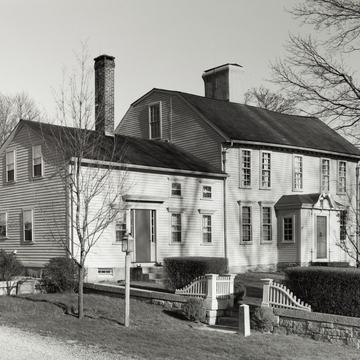This five-bay, central-chimney house with a gambrel roof and a saltbox lean-to at the rear features an unusual enclosed entrance vestibule projecting from its front elevation, a later enlargement of the small front stair hall, perhaps when the Smiths first occupied the house in 1848. Both the proportioning of the broken-scroll pediment over the entrance, no doubt the original reapplied on the addition, and the tall, narrow proportions of its nine-over-nine windows are distinctive. The wing, with its own tall chimney, served as the office of what is reputed to have been Westerly's first doctor. It also served as the first post office in Westerly, which Benjamin Franklin visited while he served as postmaster general.
You are here
Dr. Joshua Babcock–Orlando Smith House
If SAH Archipedia has been useful to you, please consider supporting it.
SAH Archipedia tells the story of the United States through its buildings, landscapes, and cities. This freely available resource empowers the public with authoritative knowledge that deepens their understanding and appreciation of the built environment. But the Society of Architectural Historians, which created SAH Archipedia with University of Virginia Press, needs your support to maintain the high-caliber research, writing, photography, cartography, editing, design, and programming that make SAH Archipedia a trusted online resource available to all who value the history of place, heritage tourism, and learning.














